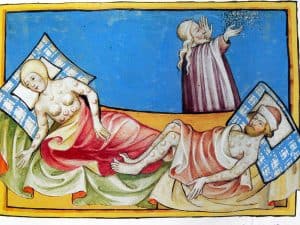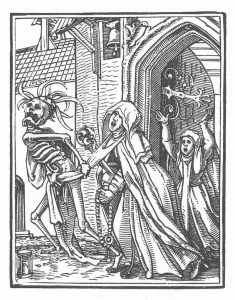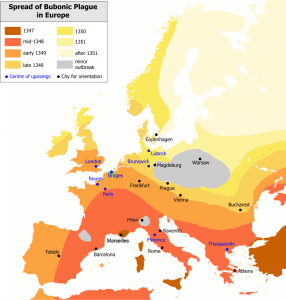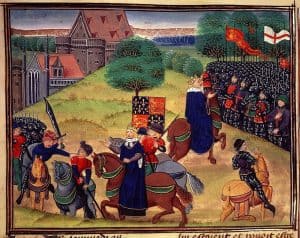
In 1348 Betchworth was struck by the Bubonic Plague. The 14th century outbreak, known as the Black Death, is probably the most horrific pandemic ever to have afflicted mankind. It killed without mercy: rich and poor, high and low, saint and sinner.
We cannot know how many died in Betchworth, but it is thought to have been between 160 and 240 out of a population of about 400. (Population numbers probably took until 1450 to recover.)

To the populace it seemed that God had deserted them – or that they were being punished for the sins of mankind.
The disaster led ordinary people to ask questions of their rulers and betters. In the medieval period there were three ‘estates’ of person: those who prayed, those who fought, and those who worked the land to feed the population. If those who prayed were unable to protect the population by their prayers, and those who fought could not protect them with their swords (or even worse, ran away), then why should those who worked feed the clerics and the lords?
Wages rose as the disease killed so many working people; land lost its value for lack of heirs to inherit and farm. These developments threatened the position of landowners. Repressive attempts to prevent wage rises compounded dissatisfaction with the social order, and the economic and social consequences of the Black Death are thought to have lead to the Peasants’ Revolt in 1381.

The 14th century outbreak of plague originated in China in the 1330s. The infection is thought to have been spread by infected fleas carried by rats. By 1347 it had arrived in the Eastern Mediterranean. The first known case in England was a seaman who had arrived in Weymouth from France in June 1348. By the autumn of the following year, the whole country was affected. It is estimated that before it died out, in December 1349, 40-60% of the population had perished.
Bubonic Plague has never been eradicated, and is still endemic to certain parts of the world.
There are two phases to the disease. In the first, most virulent stage, sufferers endure fever and spit blood. Death comes within three days, sometimes within hours. In the second, less virulent phase, those affected suffer fever, boils, and black ‘buboes’ in the groin and armpits. Death comes within five days. Few survive.
The Dead of Brockham
The names of many of the dead were recorded in the manorial records. During the medieval period, when an un-free tenant, or an owner of copyhold land, died, his or her death was recorded in the manorial records, and a heriot was payable to the lord of the manor; this was usually the best beast. A fine was also levied on the heir before he or she could take possession. This was a monetary payment and varied according to the size of the holding.
In the manors of Betchworth and Brockham, the youngest son inherited copyhold land; if there was no son, the youngest daughter would inherit. But during the Black Death so many died that other blood relatives often inherited.
We have the manorial records for the neighbouring manor of Brockham. Betchworth’s fatality rate is likely to have been similar.
There was social tension in Betchworth even before the Black Death. In the early 1300s tenants ran hundreds of illegal animals, particularly sheep, on the manor’s land in mass trespasses; one man, John Cornmonger, was fined for trespassing more than 100 sheep in 1326.
The Peasants’ Revolt

The origins of the Peasants’ Revolt of 1381 lie in the social and economic changes caused by the Black Death of 1347. In this image the peasants’ leader, Wat Tyler, can be seen being killed on the left. The young King Richard II can be seen twice in the picture, speaking to the crowd on the right and also watching the killing.
Last : Betchworth’s Royal Dolphin
Next : From Betchworth to Agincourt

